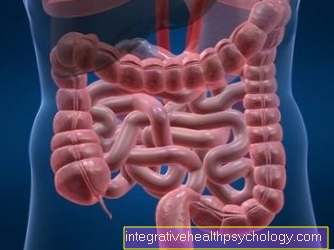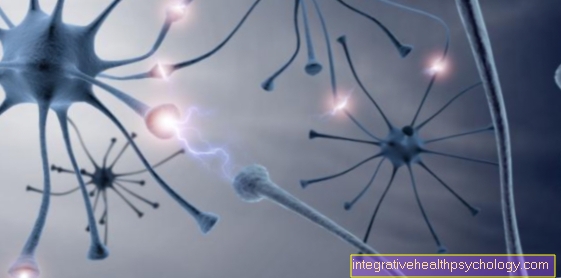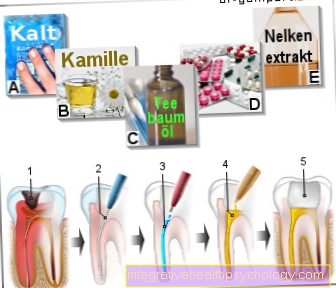Intussusception
Synonyms in a broader sense
Medical: Intussusception, invagination of the intestine
English: intussusception
definition
Intussusception is a telescopic invagination of one section of the intestine into another. It occurs mainly in small children and in the worst case can be life-threatening.
Summary

In infants and small children, intussusception can occur as a result of increased bowel motility or in connection with infections. As a rule, a part of the intestine turns into the following part in the (aboral) direction leading away from the mouth. The proper movement of the intestinal wall (Peristalsis) this invagination can progress further.
Since the wall of the intestine is folded during intussusception, the flow of blood through the veins is impeded and blood congestion occurs, as a result of which water from the vessels enters the wall tissue (edema) and floats it up. This further reduces the blood supply and symptoms of an intestinal obstruction (Ileus) occur. This can lead to a life-threatening situation for the child, which is why rapid treatment of intussusception in the hospital is necessary.
Forms of intussusception
Depending on the anatomical position of the Intussusception a distinction is made different shapes:
The most common ileo-cecal intussusception with the end part of the small intestine (Ileum) into the appendix portion of the large intestine (Cecum) invades. When making the diagnosis, a Appendicitis (appendicitis) should be thought.
Other forms of intussusception are the ileo-colical (Small intestine in Large intestine), ileo-ileale (Small intestine in small intestine), colical (Large intestine in large intestine) or ileo-ileo-colical (Small intestine in small intestine and additionally in large intestine).
It can rarely be used for Inversion of a part of the stomach into the esophagus (Esophagus), which is more likely to occur in adults.
Epidemiology
In 90% of the cases one occurs Intussusception at Infants and Toddlers between the ages of 4 months and 3 years. Although not well known, intussusception is a relatively common disease: around 1 in 1000 children fall ill every year.
causes
In most cases, intussusception occurs with no apparent cause (idiopathic).
- A high mobility of the intestine in the first years of life
- an intestinal infection (Enteritis), mostly caused by viruses (Rotaviruses, Adenoviruses)
- or a special vascular inflammation (Henoch-Schönlein purpura)
can be considered as the cause.
Read more on the topic: Purpura Schönlein Enoch
Symptoms of intussusception
This is characteristic of intussusception phased course of symptoms. The child often has sudden strengths at the beginning cramping abdominal pain, weeps and looks sickly. This is usually followed by a symptom-free period, which is typically caused by the child's sudden high-pitched screaming in connection with the Tightening your legs or taking a squatting position is interrupted. It can be gushy Vomiting with sweats Come on, the child becomes increasingly lethargic and in the worst case can unconscious become. These symptoms indicate a bowel obstruction (Ileus) and the child must be taken to hospital immediately.
diagnosis
By the characteristic symptoms the suspicion of intussusception is quickly raised. After admission to the hospital, this suspicion must be confirmed and other illnesses, such as a Appendicitis (appendicitis) or severe constipation (Constipation) can be excluded.
In the physical exam a cylindrical bump can be felt, often in the area of the right lower abdomen. In 10-20% of cases, blood is found on the glove after examining the rectum with the finger.
in the Ultrasound image one can use a double ring structure (cockade, Target phenomenon), which corresponds to the cross-sectional image of the two intestinal tubes. Thus the diagnosis of intussusception is clear.
If in doubt, a X-ray of the abdomen (abdomen overview) can be made with a contrast agent enema. This has the advantage that in addition to the clear image diagnosis, therapy can be started directly.
Therapy of intussusception
To the Intestinal invagination one tries to undo with the help of
- Air (pneumatic disinvagination)
- Saline solution (NaCl solution) or
- water-soluble contrast medium (hydrostatic reduction)
To unfold the intestine again (devagination). For this, the air or liquid is introduced into the large intestine via an intestinal tube and the invaginated part of the intestine (invaginate) is pushed back into its original position by the pressure on it. An ultrasound or X-ray image is taken as a check. This therapy is most promising within the first 14 hours, which is why it is important to get the child to the hospital quickly.
If this method does not work, the only option left is the operation (laparotomy). Here the abdomen is opened and the intestinal parts are manually brought back into the correct position.
If the intestine is already too severely damaged by intussusception as a result of reduced blood flow, the affected section must be removed (Resection).
Because of the risk of renewed intussusception, the child must remain in the hospital for at least 24 hours for observation, and correspondingly longer after surgery.
forecast
A Intussusception usually goes without problems if treated quickly and the child is fine again after a short time.
In the case of intussusception, the decisive factor for the outcome is the length of time in which the affected section of the intestine cannot be adequately supplied with blood. The longer this time, the higher the risk that the part of the organ will perish and a life-threatening situation for the child will arise.
So it's important to have one Intussusception quickly to detect and swiftly to to treat.

















.jpg)











